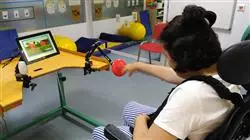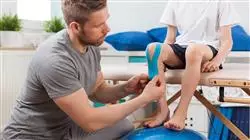University certificate
The world's largest faculty of medicine”
Introduction to the Program
This Professional master’s degree provides you with the latest knowledge in techniques and materials used in Pediatric Orthopedics, including modules on osteoarticular infections and dysplasias”

The incursion of technologies applied to medicine has recently led to an increase in the number of interventions performed by means of surgeries navigated with mixed reality, bioresorbable implants or general improvements in osteosynthesis materials. A boost to Pediatric Orthopedics, which, in turn, starts from a knowledge base of the entire locomotor system of the child.
In addition to treatment itself, advances in diagnosis, on which professionals in the field are constantly working, continue to be key. An early and adequate detection of certain pathologies favors child recovery, which is also undergoing full development. That is why more and more specialists are demanding to renew their knowledge in the field. This Professional master’s degree is born in this context, where physicians will delve into radial longitudinal deficiency of the upper limb, Embryology, anatomy and biomechanics of the hip, Osgood-Schlatter disease or the staging of musculoskeletal tumors.
The multimedia didactic material provided by TECH on all its programs, will allow professionals to access advanced knowledge through video summaries, detailed videos, interactive diagrams and clinical case simulations. All this, with the main objective that students acquire up-to-date knowledge in the field.
What is more, professionals are offered higher education in a convenient and flexible format. Students only need an electronic device with an Internet connection to access the virtual campus, the syllabus and the rest of the material. All of which will be available from the very first day. This will allow students to distribute the course load according to their needs, with a 100% online program, and no fixed class schedules. An ideal program for people looking for a university qualification that allows them to balance their work and personal responsibilities.
A 100% online academic program designed for professionals like you, who wish to balance their work responsibilities with a quality education”
This Professional master’s degree in Pediatric Orthopedics contains the most complete and up-to-date scientific program on the market. The most outstanding features of the Professional master’s degree are:
- Developing practical cases presented by experts in Pediatric Orthopedics
- The graphic, schematic, and practical contents with which they are created, provide scientific and practical information on the disciplines that are essential for professional practice
- Practical exercises where the self-assessment process can be carried out to improve learning
- Its special emphasis on innovative methodologies in Pediatric Orthopedics
- Theoretical lessons, questions to the expert, debate forums on controversial topics, and individual reflection assignments
- Content that is accessible from any fixed or portable device with an Internet connection
From your computer and at any time, you can comfortably update your knowledge of osteoid osteoma or aneurysmal bone cyst”
The program’s teaching staff includes professionals from the sector who contribute their work experience to this training program, as well as renowned specialists from leading societies and prestigious universities.
The multimedia content, developed with the latest educational technology, will provide the professional with situated and contextual learning, i.e., a simulated environment that will provide immersive specialization programmed to learn in real situations.
This program is designed around Problem-Based Learning, whereby the professional must try to solve the different professional practice situations that arise throughout the program. For this purpose, the student will be assisted by an innovative interactive video system created by renowned and experienced experts.
Access the most recent scientific studies in the early diagnosis of adolescent hip pathology"

This program will help you update your knowledge of the emergency approach to pediatric patients with spine pathology, torticollis or atlantoaxial instability"
Why study at TECH?
TECH is the world’s largest online university. With an impressive catalog of more than 14,000 university programs available in 11 languages, it is positioned as a leader in employability, with a 99% job placement rate. In addition, it relies on an enormous faculty of more than 6,000 professors of the highest international renown.

Study at the world's largest online university and guarantee your professional success. The future starts at TECH”
The world’s best online university according to FORBES
The prestigious Forbes magazine, specialized in business and finance, has highlighted TECH as “the world's best online university” This is what they have recently stated in an article in their digital edition in which they echo the success story of this institution, “thanks to the academic offer it provides, the selection of its teaching staff, and an innovative learning method aimed at educating the professionals of the future”
A revolutionary study method, a cutting-edge faculty and a practical focus: the key to TECH's success.
The most complete study plans on the university scene
TECH offers the most complete study plans on the university scene, with syllabuses that cover fundamental concepts and, at the same time, the main scientific advances in their specific scientific areas. In addition, these programs are continuously being updated to guarantee students the academic vanguard and the most in-demand professional skills. In this way, the university's qualifications provide its graduates with a significant advantage to propel their careers to success.
TECH offers the most comprehensive and intensive study plans on the current university scene.
A world-class teaching staff
TECH's teaching staff is made up of more than 6,000 professors with the highest international recognition. Professors, researchers and top executives of multinational companies, including Isaiah Covington, performance coach of the Boston Celtics; Magda Romanska, principal investigator at Harvard MetaLAB; Ignacio Wistumba, chairman of the department of translational molecular pathology at MD Anderson Cancer Center; and D.W. Pine, creative director of TIME magazine, among others.
Internationally renowned experts, specialized in different branches of Health, Technology, Communication and Business, form part of the TECH faculty.
A unique learning method
TECH is the first university to use Relearning in all its programs. It is the best online learning methodology, accredited with international teaching quality certifications, provided by prestigious educational agencies. In addition, this disruptive educational model is complemented with the “Case Method”, thereby setting up a unique online teaching strategy. Innovative teaching resources are also implemented, including detailed videos, infographics and interactive summaries.
TECH combines Relearning and the Case Method in all its university programs to guarantee excellent theoretical and practical learning, studying whenever and wherever you want.
The world's largest online university
TECH is the world’s largest online university. We are the largest educational institution, with the best and widest online educational catalog, one hundred percent online and covering the vast majority of areas of knowledge. We offer a large selection of our own degrees and accredited online undergraduate and postgraduate degrees. In total, more than 14,000 university degrees, in eleven different languages, make us the largest educational largest in the world.
TECH has the world's most extensive catalog of academic and official programs, available in more than 11 languages.
Google Premier Partner
The American technology giant has awarded TECH the Google Google Premier Partner badge. This award, which is only available to 3% of the world's companies, highlights the efficient, flexible and tailored experience that this university provides to students. The recognition as a Google Premier Partner not only accredits the maximum rigor, performance and investment in TECH's digital infrastructures, but also places this university as one of the world's leading technology companies.
Google has positioned TECH in the top 3% of the world's most important technology companies by awarding it its Google Premier Partner badge.
The official online university of the NBA
TECH is the official online university of the NBA. Thanks to our agreement with the biggest league in basketball, we offer our students exclusive university programs, as well as a wide variety of educational resources focused on the business of the league and other areas of the sports industry. Each program is made up of a uniquely designed syllabus and features exceptional guest hosts: professionals with a distinguished sports background who will offer their expertise on the most relevant topics.
TECH has been selected by the NBA, the world's top basketball league, as its official online university.
The top-rated university by its students
Students have positioned TECH as the world's top-rated university on the main review websites, with a highest rating of 4.9 out of 5, obtained from more than 1,000 reviews. These results consolidate TECH as the benchmark university institution at an international level, reflecting the excellence and positive impact of its educational model.” reflecting the excellence and positive impact of its educational model.”
TECH is the world’s top-rated university by its students.
Leaders in employability
TECH has managed to become the leading university in employability. 99% of its students obtain jobs in the academic field they have studied, within one year of completing any of the university's programs. A similar number achieve immediate career enhancement. All this thanks to a study methodology that bases its effectiveness on the acquisition of practical skills, which are absolutely necessary for professional development.
99% of TECH graduates find a job within a year of completing their studies.
Professional Master's Degree in Pediatric Orthopedics
The development of new surgical intervention alternatives in the area, the implementation of new corrective appliances and the use of new treatment systems for the care of ligament injuries make pediatric orthopedics one of the most evolving fields of medicine in recent years. This situation has led professionals specialized in the field to the constant search for academic programs that allow them to remain at the forefront of the most significant developments in the sector and access, thus, to better occupational opportunities in the area. Understanding this fact, in TECH Global University we have designed our Professional Master's Degree program in Pediatric Orthopedics focused on the training of the professional. This postgraduate program will pay special attention to the new arthroscopic treatment alternatives in the management of hip dysplasia cases in older children and adolescents. Likewise, the following concepts will be updated: knowledge of the new possibilities of orthopedic intervention in the care of patients with spondylolisthesis; and the particularities and elements to be considered in the management and immobilization of pediatric fractures.
Study an Online Professional Master's Degree in Pediatric Orthopedics
Due to the morphological and behavioral characteristics of the patients to be treated, pediatric orthopedics stands out as a field in which communication skills and timely management of crisis situations are fundamental values for professionals in the area. In our Professional Master's Degree program you will approach pediatric orthopedics from the identification of the skills, abilities and knowledge necessary for an adequate development in the demanding scenarios that accompany the development of the sector. Likewise, in this postgraduate program you will delve into the modernization of the following aspects: the identification of the different ways of intervention and treatment in the care of patients with osteochondritis dissecans of the knee; and the knowledge of the different alternatives of surgical approach in the management of cases of epiphysiolysis of the femoral head.







